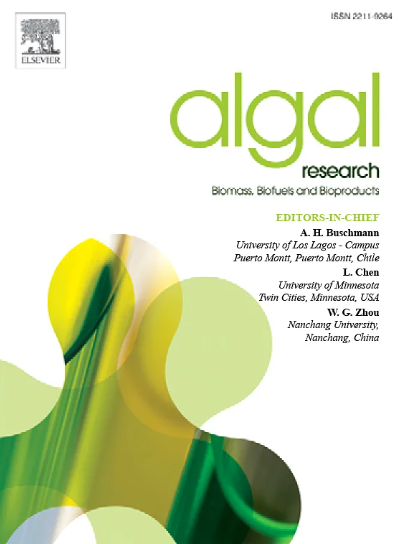Immobilized Chlorella salina for removing nitrogenous and phosphorous compounds from mariculture tail water
IF 4.6
2区 生物学
Q1 BIOTECHNOLOGY & APPLIED MICROBIOLOGY
Algal Research-Biomass Biofuels and Bioproducts
Pub Date : 2025-01-21
DOI:10.1016/j.algal.2025.103930
引用次数: 0
Abstract
The rapid development of the maricultural industry has brought both economic benefits and environmental challenges. One such challenge is the purification of mariculture tail water (MTW), which has become a key issue of marine environmental protection. Meanwhile, immobilized algal beads (IAB), has received growing attention as cost-effective wastewater treatment technology. However, most of the studies on the treatment of aquaculture tail water by IAB focus on the application of freshwater, and the use of seawater remains relatively rare. This study investigated the screening of algal species and embedding particle size suitable for the treatment of artificial MTW![]() I, the optimization of algal beads preparation using the response surface method, and their application in treating artificial MTW-II. The results showed that immobilized Chlorella salina harbouring particle size of 3.2 mm were most effective for removing N from artificial MTW
I, the optimization of algal beads preparation using the response surface method, and their application in treating artificial MTW-II. The results showed that immobilized Chlorella salina harbouring particle size of 3.2 mm were most effective for removing N from artificial MTW![]() I. IAB fabricated under the optimized conditions of 4.2 % (w/v) sodium alginate (SA), 1 × 107 cells·mL−1 initial density of C. salina and 130 mL algal cells volume achieved the highest NH4-N removal efficiency (75.780 %) during the 72 h experiment. Although immobilized cultivation inhibited algal cell photosynthesis, it also promoted their growth and NH4-N removal ability. Groups with 10 % algal beads exhibited a better purification effect and could treat 5 batches of artificial MTW-II containing 815.75 mg of inorganic nitrogen and 71.80 mg of phosphate. Furthermore, the addition of 2 % algal beads was the most cost-effective scheme, resulting in a treatment cost of approximately 3.50 RMB per ton of tail water and 0.33 RMB per gram of inorganic nitrogen. These findings provide unique insight into marine environmental protection and suggest that IAB application offers a promising method for integrated MTW treatment.
I. IAB fabricated under the optimized conditions of 4.2 % (w/v) sodium alginate (SA), 1 × 107 cells·mL−1 initial density of C. salina and 130 mL algal cells volume achieved the highest NH4-N removal efficiency (75.780 %) during the 72 h experiment. Although immobilized cultivation inhibited algal cell photosynthesis, it also promoted their growth and NH4-N removal ability. Groups with 10 % algal beads exhibited a better purification effect and could treat 5 batches of artificial MTW-II containing 815.75 mg of inorganic nitrogen and 71.80 mg of phosphate. Furthermore, the addition of 2 % algal beads was the most cost-effective scheme, resulting in a treatment cost of approximately 3.50 RMB per ton of tail water and 0.33 RMB per gram of inorganic nitrogen. These findings provide unique insight into marine environmental protection and suggest that IAB application offers a promising method for integrated MTW treatment.
求助全文
约1分钟内获得全文
求助全文
来源期刊

Algal Research-Biomass Biofuels and Bioproducts
BIOTECHNOLOGY & APPLIED MICROBIOLOGY-
CiteScore
9.40
自引率
7.80%
发文量
332
期刊介绍:
Algal Research is an international phycology journal covering all areas of emerging technologies in algae biology, biomass production, cultivation, harvesting, extraction, bioproducts, biorefinery, engineering, and econometrics. Algae is defined to include cyanobacteria, microalgae, and protists and symbionts of interest in biotechnology. The journal publishes original research and reviews for the following scope: algal biology, including but not exclusive to: phylogeny, biodiversity, molecular traits, metabolic regulation, and genetic engineering, algal cultivation, e.g. phototrophic systems, heterotrophic systems, and mixotrophic systems, algal harvesting and extraction systems, biotechnology to convert algal biomass and components into biofuels and bioproducts, e.g., nutraceuticals, pharmaceuticals, animal feed, plastics, etc. algal products and their economic assessment
 求助内容:
求助内容: 应助结果提醒方式:
应助结果提醒方式:


